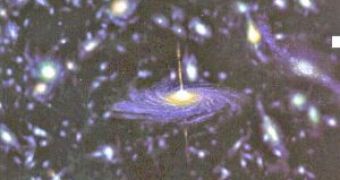It seems that the oldest stuff from our Universe is ... some cosmic glow.
This is remnant radiation from the first stars or black holes born in our universe.
The deepest space reaches of space are wrapped by a cloak of infrared radiation, an uneven energy swath left by long-dead objects from the primordial universe.
Now, astronomers have tore apart overlapping signals from that cosmic infrared background, correlating them to previous studies to point that they may actually come from the first objects to emerge from the Big Bang.
Those objects may be either extremely bright stars more than 1,000 times more massive than our sun, or quasars (photo), large black holes that consume enormous amounts of gas and debris and spit off the materials in almost unparalleled bursts of energy.
If the energy patches are star clusters, they may be the first galaxies, smaller than most known galaxies yet containing a mass on the scale of 1 million suns.
The research team used archival data from the calibration of the NASA Spitzer telescope and made several stages of cleaning to remove signals from more recent galaxies and other objects to get to the underlying signals.
"Observing the cosmic infrared background is like watching distant fireworks from within a brightly lit city," said lead author Alexander Kashlinsky of NASA's Goddard Space Flight Center in Greenbelt, Md.
"It's as if we have turned off the city lights one by one to see the bursts more clearly. While we can't resolve each spark in the fireworks, we can see the large scale structures and their glow."
The team made observations of four regions of the night sky, two from each hemisphere, to data the telescope collected during a calibration last year.
The new observations, with exposure times of up to 25-26 hours per pixel, peered four times deeper into the universe than the earlier research and greatly expanded the observation area.

 14 DAY TRIAL //
14 DAY TRIAL //